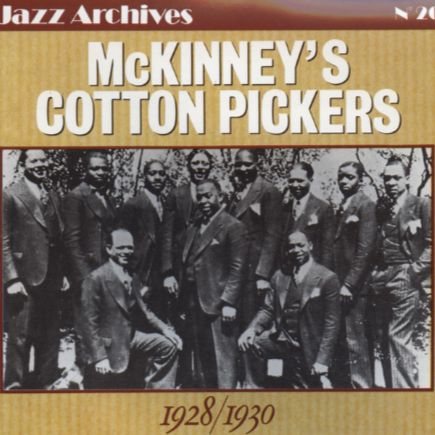McKinney’s Cotton Pickers, l’élégance orchestrale du jazz de Detroit
Fondé à Detroit en 1926 par le batteur William McKinney, le groupe McKinney’s Cotton Pickers s’impose rapidement comme l’un des orchestres les plus influents de la période pré-swing. Issu de l’extension du Synco Septet originel à dix musiciens, l’ensemble devient sous sa direction un véritable laboratoire d’innovations musicales, annonçant les développements orchestraux du swing à venir. Entre 1927 et 1931, le big band connaît un succès retentissant, notamment grâce à ses enregistrements pour le label Victor, qui figurent parmi les meilleures ventes de l’époque.
Le nom du groupe, volontairement évocateur, fait référence aux cueilleurs de coton afro-américains, symbolisant à la fois la mémoire du Sud et la fierté d’une identité culturelle en plein essor. C’est en 1927 que le destin du groupe bascule: Don Redman, ancien arrangeur et saxophoniste de Fletcher Henderson, en devient le directeur musical.
Sa maîtrise de l’orchestration, son sens des contrastes et sa capacité à faire dialoguer les sections transforment l’ensemble en un modèle d’équilibre et de cohésion. Redman y introduit une écriture raffinée, combinant virtuosité instrumentale et précision collective, tout en conservant l’énergie spontanée propre au jazz.
Le noyau des McKinney’s Cotton Pickers réunit quelques-uns des musiciens les plus talentueux de la scène de Detroit: les trompettistes Langston Curly et John Nesbitt, les saxophonistes Milton Senior et George Thomas, le clarinettiste Prince Robinson, le pianiste Todd Rhodes, le banjoïste Dave Wilborn, le corniste Bob Escudero et le batteur Cuba Austin.
Cette instrumentation riche permet à Redman d’expérimenter des textures inédites et des dialogues polyphoniques d’une grande modernité. Les McKinney’s Cotton Pickers deviennent ainsi l’un des premiers à concevoir des arrangements intégrant de véritables échanges entre les pupitres, au lieu des simples successions de soli individuels alors en vogue.
Vers la fin de 1929, les McKinney’s Cotton Pickers attirent l’attention de plusieurs figures majeures du jazz new-yorkais. Des solistes invités tels que Coleman Hawkins et Fats Waller participent à une série d’enregistrements marquants, qui témoignent du rayonnement national de la formation. Au fil des ans, d’autres grands musiciens comme Benny Carter, James P. Johnson, Buddy Lee ou Rex Stewart rejoignent l’ensemble, enrichissant encore son répertoire et sa notoriété.
Lorsque Redman quitte la direction musicale en 1931, remplacé par Benny Carter, le groupe conserve un haut niveau artistique mais subit le déclin économique de la Grande Dépression. En 1934, l’orchestre se dissout, emporté par les bouleversements du marché musical et par l’émergence du swing incarné par Louis Armstrong et les grands big bands des années trente.
McKinney’s Cotton Pickers, la elegancia orquestal del jazz de Detroit
Fundado en Detroit en 1926 por el baterista William McKinney, el grupo McKinney’s Cotton Pickers se impuso rápidamente como una de las orquestas más influyentes del período pre-swing. Nacido de la ampliación del Synco Septet original a diez músicos, el conjunto se convirtió bajo su dirección en un auténtico laboratorio de innovación musical, anticipando los desarrollos orquestales del swing que estaba por venir. Entre 1927 y 1931, el big band alcanzó un éxito extraordinario, gracias especialmente a sus grabaciones para el sello Victor, que se contaban entre los mayores éxitos comerciales de la época.
El nombre del grupo, deliberadamente evocador, hacía referencia a los recolectores de algodón afroamericanos, símbolo tanto de la memoria del Sur como del orgullo de una identidad cultural en expansión. En 1927, el destino del grupo cambió radicalmente con la llegada de Don Redman, antiguo arreglista y saxofonista de Fletcher Henderson, quien asumió la dirección musical.
Su dominio de la orquestación, su sentido de los contrastes y su capacidad para hacer dialogar las secciones transformaron el conjunto en un modelo de equilibrio y cohesión. Redman introdujo una escritura refinada que combinaba la virtuosidad individual con la precisión colectiva, sin perder la energía espontánea característica del jazz.
El núcleo de los McKinney’s Cotton Pickers reunía a algunos de los músicos más talentosos de la escena de Detroit: los trompetistas Langston Curly y John Nesbitt, los saxofonistas Milton Senior y George Thomas, el clarinetista Prince Robinson, el pianista Todd Rhodes, el banjista Dave Wilborn, el cornista Bob Escudero y el baterista Cuba Austin.
Esta instrumentación variada permitió a Redman experimentar con nuevas texturas y diálogos polifónicos de gran modernidad. Los McKinney’s Cotton Pickers fueron así de los primeros en concebir arreglos que integraban verdaderos intercambios entre secciones, en lugar de simples sucesiones de solos individuales.
Hacia finales de 1929, los McKinney’s Cotton Pickers atrajeron la atención de figuras destacadas del jazz neoyorquino. Solistas invitados como Coleman Hawkins y Fats Waller participaron en una serie de grabaciones memorables que consolidaron la proyección nacional de la agrupación. Con el paso de los años, otros grandes músicos como Benny Carter, James P. Johnson, Buddy Lee o Rex Stewart se unieron al grupo, enriqueciendo su repertorio y aumentando su prestigio.
Cuando Redman dejó la dirección musical en 1931, sustituido por Benny Carter, la orquesta mantuvo un alto nivel artístico, pero sufrió las consecuencias de la Gran Depresión. En 1934, el grupo se disolvió, arrastrado por la crisis económica y por el surgimiento del swing, impulsado por Louis Armstrong y las grandes big bands de los años treinta.
McKinney’s Cotton Pickers, l’eleganza orchestrale del jazz di Detroit
Fondato a Detroit nel 1926 dal batterista William McKinney, il gruppo McKinney’s Cotton Pickers si impose rapidamente come una delle orchestre più influenti del periodo pre-swing. Nato dall’ampliamento del Synco Septet originale a dieci musicisti, l’ensemble divenne sotto la sua direzione un vero laboratorio di innovazione musicale, anticipando gli sviluppi orchestrali dello swing che di lì a poco avrebbe dominato la scena. Tra il 1927 e il 1931, la big band conobbe un successo clamoroso, grazie in particolare alle incisioni per l’etichetta Victor, che si classificarono tra i maggiori successi commerciali dell’epoca.
Il nome del gruppo, volutamente evocativo, si riferiva ai raccoglitori di cotone afroamericani, simbolo al tempo stesso della memoria del Sud e dell’orgoglio di un’identità culturale in piena espansione. Nel 1927, il destino del gruppo cambiò quando Don Redman, già arrangiatore e sassofonista di Fletcher Henderson, ne assunse la direzione musicale.
La sua padronanza dell’orchestrazione, il senso dei contrasti e la capacità di far dialogare le sezioni trasformarono l’ensemble in un modello di equilibrio e coesione. Redman introdusse una scrittura raffinata che univa la virtuosità dei singoli alla precisione collettiva, mantenendo al contempo l’energia spontanea tipica del jazz.
Il nucleo dei McKinney’s Cotton Pickers riuniva alcuni dei musicisti più talentuosi della scena di Detroit: i trombettisti Langston Curly e John Nesbitt, i sassofonisti Milton Senior e George Thomas, il clarinettista Prince Robinson, il pianista Todd Rhodes, il banjoista Dave Wilborn, il cornista Bob Escudero e il batterista Cuba Austin.
Questa ricca strumentazione consentì a Redman di sperimentare nuove trame sonore e dialoghi polifonici di grande modernità. I McKinney’s Cotton Pickers furono tra i primi a concepire arrangiamenti che integravano veri scambi tra le sezioni, anziché le semplici successioni di soli individuali allora in voga.
Verso la fine del 1929, i McKinney’s Cotton Pickers attirarono l’attenzione di importanti figure del jazz newyorkese. Solisti ospiti come Coleman Hawkins e Fats Waller parteciparono a una serie di incisioni memorabili che testimoniano la fama nazionale della formazione. Negli anni successivi, altri grandi musicisti come Benny Carter, James P. Johnson, Buddy Lee e Rex Stewart si unirono al gruppo, arricchendone ulteriormente il repertorio e la notorietà.
Quando Redman lasciò la direzione musicale nel 1931, sostituito da Benny Carter, la band mantenne un alto livello artistico ma subì le conseguenze economiche della Grande Depressione. Nel 1934, l’orchestra si sciolse, travolta dai mutamenti del mercato musicale e dall’ascesa dello swing rappresentato da Louis Armstrong e dalle grandi big band degli anni Trenta.
McKinney’s Cotton Pickers, the orchestral elegance of Detroit jazz
Founded in Detroit in 1926 by drummer William McKinney, the McKinney’s Cotton Pickers quickly rose to prominence as one of the most influential orchestras of the pre-swing era. Evolving from the original Synco Septet into a ten-piece ensemble, the group became, under McKinney’s leadership, a genuine laboratory of musical innovation, foreshadowing the orchestral developments that would shape the swing era. Between 1927 and 1931, the big band achieved remarkable success, particularly with its recordings for the Victor label, which ranked among the top sellers of the time.
The group’s name, deliberately evocative, referred to African American cotton pickers — a tribute both to the memory of the South and to the pride of an emerging cultural identity. In 1927, the band’s destiny changed dramatically with the arrival of Don Redman, former arranger and saxophonist for Fletcher Henderson, who became its musical director.
His mastery of orchestration, keen sense of contrast, and ability to make the sections interact transformed the ensemble into a model of balance and cohesion. Redman introduced a refined style of writing that blended instrumental virtuosity with collective precision while preserving the spontaneous energy of jazz.
The core of the McKinney’s Cotton Pickers brought together some of Detroit’s most talented musicians: trumpeters Langston Curly and John Nesbitt, saxophonists Milton Senior and George Thomas, clarinetist Prince Robinson, pianist Todd Rhodes, banjoist Dave Wilborn, horn player Bob Escudero, and drummer Cuba Austin.
This rich instrumentation allowed Redman to experiment with new textures and polyphonic dialogues of great modernity. The McKinney’s Cotton Pickers were among the first to create arrangements that incorporated real interplay between sections rather than the simple succession of individual solos typical of the era.
By late 1929, the McKinney’s Cotton Pickers had attracted the attention of major New York jazz figures. Guest soloists such as Coleman Hawkins and Fats Waller took part in a series of landmark recordings that reflected the band’s growing national influence. Over time, other major musicians — including Benny Carter, James P. Johnson, Buddy Lee, and Rex Stewart — joined the ensemble, further expanding its repertoire and renown.
When Redman left his post as musical director in 1931, succeeded by Benny Carter, the group maintained its artistic excellence but was hit hard by the economic impact of the Great Depression. In 1934, the orchestra disbanded, overtaken by the shifting music industry and the rise of swing led by Louis Armstrong and the great big bands of the 1930s.


